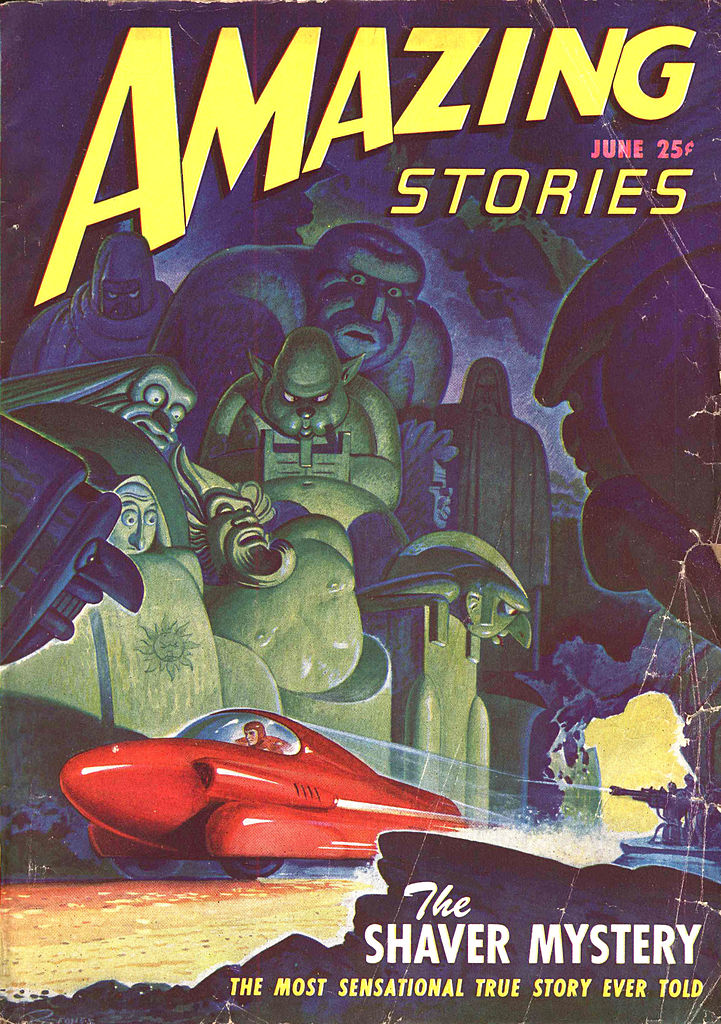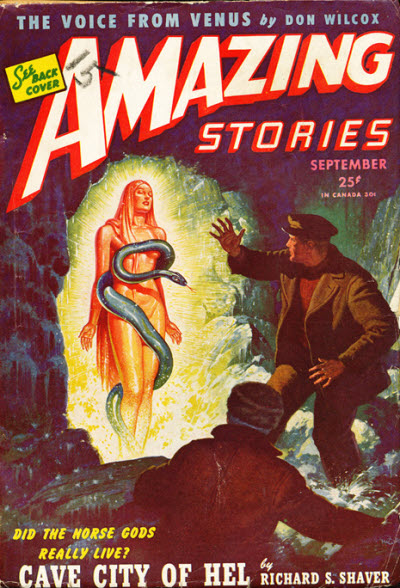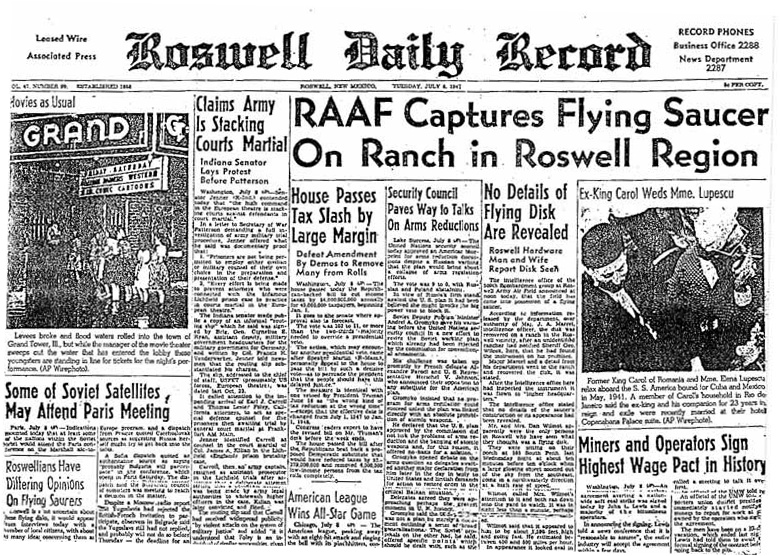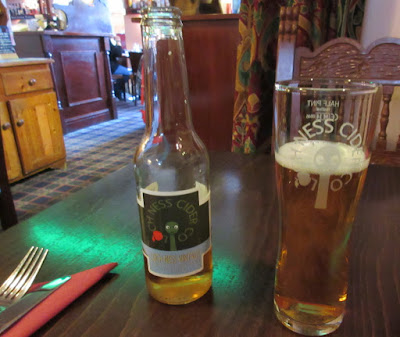UFOs are Dead, Flying Saucers Will Live Long
Amazing Stories, June 1947
Saturday will be the 70th anniversary of the Kenneth Arnold "Flying Saucers Sighting". The famous 24 June 1947 sighting is the traditional "beginning" of the Flying Saucer, kicking off a two-week craze that concluded with the Roswell Incident in July 1947.
But this wasn't the beginning of the UFO. EDIT 4 July 2017: Almost forty years ago Peter Rogerson made the same point I'm making here about UFOs vs. Flying Saucers, though as you'll read, I think the time in-between has been less than kind to the UFO. Nonetheless, I want to point this out, especially in the off-chance I read Rogerson's essay some time ago and forgot I had. I was reminded of this in an interesting review by Rogerson of a recent "estimate of the situation".
The UFO, the Unidentified Flying Object, emerged out of genuine official interest by US military institutions in the reports of things seen moving through the sky. Within a few years, institutional interest seems to have largely receded to keeping a UFO desk or project that had as much to do with public relations and institutional thoroughness as anything else.
The UFO, the Unidentified Flying Object, emerged out of genuine official interest by US military institutions in the reports of things seen moving through the sky. Within a few years, institutional interest seems to have largely receded to keeping a UFO desk or project that had as much to do with public relations and institutional thoroughness as anything else.
The UFO, and cryptozoology, and other forms of "alternative" science, or as detractors would put it, pseudoscience, also emerged out of high social status for science and scientists in the wake of massive technological and social change from the industrial revolution, and especially the dramatic technological and scientific leaps made around the period of the Second World War.
The social value of science, and the previously un-imagined discoveries made by scientists especially starting in the 19th century, made it sensible that analysis of evidence, using science (or activities that resembled science) could reveal amazing things.
The social value of science, and the previously un-imagined discoveries made by scientists especially starting in the 19th century, made it sensible that analysis of evidence, using science (or activities that resembled science) could reveal amazing things.
Plotting Flying Objects over Britain during the Second World War. Is this the model for the UFO sightings database?
Over time, the UFO came to be largely, though not exclusively associated with the Space Age, extraterrestrials, and searching for evidence of these strange craft and their occupants. The stereotype of the serious ufologist involves collecting reports for databases, creating sightings maps to detect geographical or temporal patterns, looking for commonalities, piecing together puzzles.
Amazing Stories, December 1945
The flying saucer is another matter entirely. Kenneth Arnold and others in the crucial period of the flying saucer of the mid-to-late 1940s were in no small part in the orbit of Ray Palmer (you can read FBI reports into Palmer's involvement in early flying saucers and his publishing here), champion of the Shaver Mysteries. Shaver's stories, edited by Palmer, have roots in pulp fiction and earlier alternative religious influences including Theosophy and Oahspe. The foundations of the flying saucer community were laid among occult and science fiction enthusiasts of the 1940s, and it is unsurprising that the flying saucer first took root in the 1950s in science fiction films and among the Contactees and their transparent relationship to previous new and alternative religious movements.
The UFO, an acronym suitable for the Big Science of powerful government and military institutions of the 1950s, inherently begs for trace evidence, analysis of the situation, collation of reports. While one can still find this style in ufology, it is dying on the vine. This is expressed well in two essays by Vicente-Juan Ballester Olmos and Thomas Bullard, both musing on the 70th anniversary. While Ballester Olmos, keeper of a photographic database to collate evidence, is very pessimistic, Bullard the folklorist is only mostly pessimistic, hoping that among the dross and dashed hopes there may still be a non-mundane phenomenon at the core of the UFO mystery.
However, most of what is associated with the UFO, or rather the flying saucer, is now conspiracy theory. One can argue that much of conspiracy theory can trace its massive cultural popularity to the UFO. Conspiracy and paranoia are the very bones of the flying saucer. One important ancestor of the flying saucer, and other elements of 20th century pulp fiction and occultism is Edward Bulwer-Lytton's 1871 novel The Coming Race. The children and grandchildren of this tale of an ancient underground master race with psychical powers and menace towards the surface are many, including the Shaver Mysteries. Shaver's writings are of nearly all-powerful Deros causing no end of misery through their invisible stalking and influence on surface dwellers. Their resemblance to much of conspiracy theory and mysticism surrounding the paranormal and UFOs today is profound. Pulp fiction also interjected the Reptilians into the Shaver and Flying Saucer community by the late 1940s. And while the Contactees often preached positive messages in the style of earlier decades theosophical ascended masters, there were also dark warnings of evil forces that would silence such wisdom.
Conspiracy and coverup were constituent to ufology, including with influential early leader Donald Keyhoe. Self-proclaimed serious or scientific ufology until the 1980s was largely about moving towards analysis and away from mysticism on the one hand, and conspiracy fears on the other, though this proved impossible. In previous posts on this blog, and in podcasts, I've discussed the importance of the Roswell myth in strengthening a bond between conspiracy theory and mainstream ufology.
Today, if one looks about the UFO community and its media, one finds two basic styles have supplanted the sightings trackers and account analysts. One is disclosure and expolitics, a focus on government and institutional conspiracy, promises that all will soon be revealed or leaked, and of breakaway civilizations and hidden shadow governments. A rotating cast of characters and tropes promotes or sells the idea that long-suspected truths are being hidden by illegitimate authorities and institutions, and that the imminent revelation of these truths will end the inequities of the modern day and bring about a better future.
The other is focused on ancient evidence for alien or extradimensional origins of humanity, often with a focus on origin myth or religion in one form or another. Though most prominent through various cable television programs, this element as has eclipsed every other aspect of interest in "UFOs", which seem almost an afterthought. One can easily go from dubious remains of a Roswell crash victim (actually indigenous remains in a museum) to dubious remains of an ancient alien hybrid without changing the roster. A rotating cast of characters and tropes promotes or sells the idea that
long-suspected truths are being hidden by illegitimate authorities and
institutions, and that the imminent revelation of these truths will end
the inequities of the modern day and bring about a better future.
These are not mutually exclusive. Alleged modern conspiracies become new manifestations of ancient magical secret societies, shadow governments hide ancient inhuman bloodlines.They unite into an all pervasive Lovecraftian paranoia of deep secrets and debased cults. Last year, conspiracy theories about evil cults were fashioned out of leaked political emails, and a man was just sentenced to prison for responding violently. Yet one reason these resonated so well in the conspiracy theory world is that the stolen emails came from a long-time UFO disclosure advocate, paralleling a huge amount of chatter and speculation that UFO disclosure would hinge on the US presidential election.
The most viable alternatives in small pockets of the UFO community are hopes that the UFO can show the way to better understandings of the inner self and consciousness, that UFOs are something like poltergeists or Victorian elementals, soon to be erroneously conglomerated with descriptions of tulpas.
In other words, the flying saucers are once again just one manifestation of the underground Deros. Of the Great Old Ones. Of the Coming Race. Ancient wisdom, lost history, hidden cults, subterranean horrors, psychical manifestations.
The investigation of the UFO mirrored the rise of science's social status. It's fall, and the return of ascended masters, psychical entities, and lost races makes perfect sense in an era of partisan attacks on science and neo-Victorian political and social conditions.
The UFO is dead, the flying saucers have returned.




















































